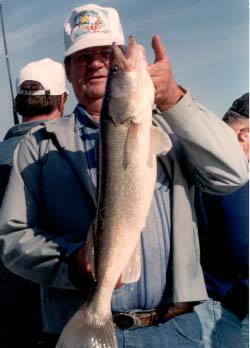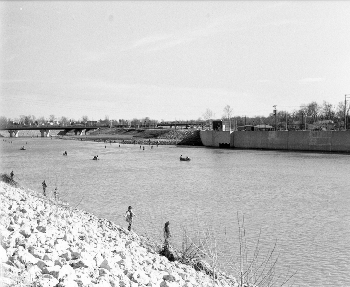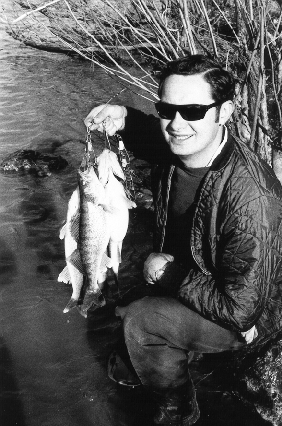 all deep water spots. Then the huge, loose schools and pods begin a slow,
measured movement toward the western end of the lake.
all deep water spots. Then the huge, loose schools and pods begin a slow,
measured movement toward the western end of the lake. Pre-Spawn
and River Walleye Tactics
By Richard Martin
Every year it happens. Like the inexorable ticking of a clock, the days grow longer, two minutes by two minutes. And as they do, Lake Erie walleye eggs and milt begin to mature and hormones trigger off behavior patterns that have changed little over thousands of years.
The
fish begin staging south of Green Island, north of such reefs as Clinton and
Cone, between North Bass and Niagara, and off the tip of Catawba island, all deep water spots. Then the huge, loose schools and pods begin a slow,
measured movement toward the western end of the lake.
all deep water spots. Then the huge, loose schools and pods begin a slow,
measured movement toward the western end of the lake.
Some
of those schools head toward reefs like Toussaint and Niagara, others favor
flats, beach areas, and rockpiles, and more seek out the Sandusky and Maumee
rivers, but they all move and as they do, offer opportunities for the first big
walleye catches of the year. And some of the fish caught will be BIG walleyes!
It's
tough fishing. Some years the ice lingers long, and anglers will often perform
the dangerous trick of walking their boat over thin ice to open water.
Foolish. other years
the ice leaves early, and launch ramps in western Lake Erie are free and ready
for use. However the weather, once boats can be launched, it's going to be cold.
Lake water won't be much above 33 degrees, snow and high winds are always
possible, and ice chunks will be floating here and there. which means anglers
had best dress warmly and carries plenty of hot coffee. But the fish have no
choice and will move, whatever the weather.
All that's necessary is to find them and then catch them.
The
finding most days isn't difficult.
At the beginning of the migration, look for them in the deep-water spots
listed above. As it progresses they' 11 move into shallower water and schools
will swim west, many of them passing the tip of Catawba Island. They might be a
half-mile offshore, or a mile or several, and depending on when you're able to
go, most could be north of the island, or west and south.
So,
one good tactic is to launch at Catawba Island State Park and head a mile or two
due west. Then anchor if necessary, or drift if the winds are gentle and
drifting is possible.
With a fish locator, pinpointing schools and pods is easy, but lacking
this basic gear most anglers anchor and fish one spot for 15 minutes then move,
and move again. Drifters just keep going, maybe working deeper or shallower on
each drift.
Anglers
will basically be using ice fishing techniques at this time of year, and that
means jigging just off bottom with spoons and jigs.
Good choices are Swedish Pimples, jigging Rapalas, Snakey Spoons, Hopkins
Spoons, and Crocodiles. Those who prefer straight jigs should try those with
twister tails, soft flaring maribou, or tinsel tails. Either way it's best to
bait all three hooks of spoons or the single hook of jigs with emerald shiners.
The minnows bouncing up and down add both eye appeal and flavor to any lure.
Keep
in mind that early fish are very cold and therefore very sluggish. A fast moving
rig won't attract them, so keep it slow and make jigs easy up and down, rather
than fast and jerky.
Strikes might be serious hits, but much more often they'll be gentle tugs
or maybe just a touch of extra weight on the line as a fish clamps down. So, use
a sensitive rod, 6-10 pound test line, and take action at any difference in the
lure.
On
my last trip for these cold water walleyes, the action was more or less typical.
We launched at Catawba State Park, moved out about two miles until the locator
showed a cluster of fish below, anchored  and
started jigging blue and silver Swedish Pimples with shiner dressing. It took
less than five minutes to feel that first gentle tug, a slow plunging fish that
materialized into a seven pound female.
and
started jigging blue and silver Swedish Pimples with shiner dressing. It took
less than five minutes to feel that first gentle tug, a slow plunging fish that
materialized into a seven pound female.
Then
my partners started picking up fish, and I caught more, filling my limit within
an hour. And thank heavens for that. Even with plenty of protective gear, my
fingers were wet and growing numb, toes weren't moving well, and the coffee had
long gone. We headed back to the dock in a hurry.
It's
worth pointing out that not all walleye follow this general migration route.
Some move into Sandusky Bay from the Marblehead area and these are the easiest
to catch of all. Several years ago I spent a few minutes studying a map of the
Bay, and found a spot where the shores pinched in dramatically. That's at the
old railroad bridge just east of old Bay Bridge and east again of fairly new
Route 2.
Every
walleye that takes this route must funnel under that bridge, and it looked like
a likely spot. I never got around to trying it, but did pass the information on
to a friend who lives up there, and he said, "It's a great place all right.
once we tried it and couldn't stay because of the current, but twice we
found the current slow and limited out under the bridge both times." It's
worth a look.
Once
spawning begins, many fishermen head for various flats, and work off the beach
areas, rock piles, and near such reefs as Niagara, Toussaint, Crib and Locust
Point Reef. These areas will account for lunker walleyes, up to 10 pounds and
better on spoons and jigs, but it's worth pointing out that older and larger
fish aren't that great eating, and are better left to spawn and produce a new
generation. When I hit these pre-spawn fish, my keepers are the nice little 2-4
pound jacks, and all others go back.
But that's a choice each fisherman must make himself.
Each
year a substantial number of fish enter the Sandusky and Maumee rivers, and
these are a bonanza for boatless anglers. Easy access, no cost for charters or
headboats, just a few jigs and patience.  And hopefully a little extra knowledge. The jacks arrive in the river
first, often by very early March, weather deciding. And while they're waiting
for the larger females to arrive, some will strike a bait.
But once serious spawning begins, it can be tough to interest a lovelorn
walleye in food.
And hopefully a little extra knowledge. The jacks arrive in the river
first, often by very early March, weather deciding. And while they're waiting
for the larger females to arrive, some will strike a bait.
But once serious spawning begins, it can be tough to interest a lovelorn
walleye in food.
The
first point to keep in mind for this river fishing is that there are lots of
regulations on both rivers. Among them are restrictions on the most popular
fishing areas. on the Sandusky, the regulated stretch runs through downtown
Fremont from the Toledo Edison power line to the northern tip of Bradys Island.
And
on the Maumee, it's from the Ohio Turnpike bridge to the Old Waterville
interurban bridge at the end of Forest Road and from the SR 578 bridge to the
Grand Rapids Providence dam. Only single hooks are allowed too, and there are
other regulations.
Read them carefully, because both rivers are usually swarming with
wildlife officers in plain clothes looking for snaggers and other miscreants.
Most
of the anglers who fish these rivers spend their time casting quarter or eighth
ounce twistertail jigs in chartreuse, white, yellow, and red slightly upstream
and let the lure sink to bottom before making a slow retrieve. Occasionally this
works, and the fish is actually mouth hooked, instead of snagged.
But
you' 11 have better luck adding a small minnow or piece of worm to the hook,
then strike at any change in resistance. Some try live bait too, maybe a 2-3
inch minnow or whole night crawler on a slip sinker, and tight line in pools or
other likely places where fish will stop to rest.
With
a small boat you can move downstream past the crowds and jig for fish that
haven't yet seen swarms of doll flies. or test the old Michigan trick of
drifting downriver exactly as fast as the current, and jigging an eighth or
sixteenth ounce doll fly just off bottom. Again, with a little bait added for
allure.
Sometimes
a nice cluster of fish will move upriver and action will be fairly fast for
those who can keep their baits down and moving slowly. Sometimes no new fish
will arrive for several days, and fishing can be slow. Weather is always
important on any river, too.
The
best time to fish is after a good rain that swells the river and turns it almost
chocolate. As the water recedes and begins to clear, it's time to go fishing,
since each rain will bring up new fish. Trying your luck on a low, clear river
or on one too muddy to allow more than inches visibility is always iffy.
And
remember, if nothing is producing a catch, turn to the unusual. Try removing the
standard treble hook from a small jigging spoon, and adding a proper single
hook. Then Dig Dust off bottom with a minnow dressing and see what happens. or
use a worm rig with single hook and spinner. or some incredibly gaudy doll fly.
Maybe nothing will happen, but then again ....